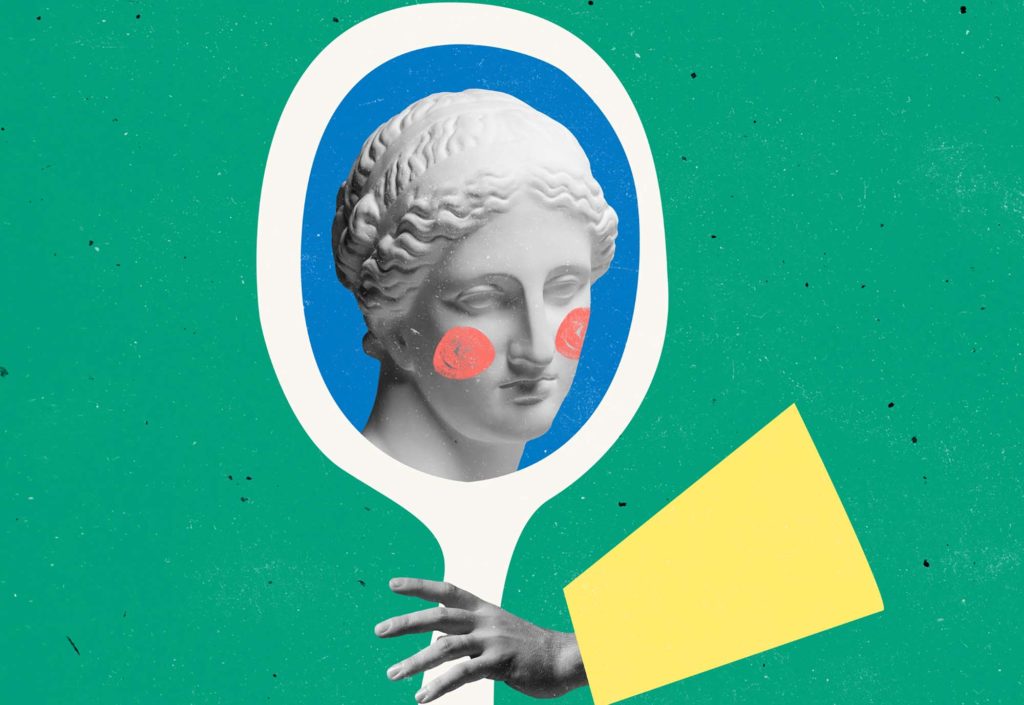In the “I” of the Beholder: People Believe Self-Relevant Artwork is More Beautiful

People have fairly consistent preferences when it comes to judging the beauty of things in the real world—it’s well known, for example, that humans prefer symmetrical faces. But our feelings about art may be more personal, causing us to prefer art that speaks to our sense of self, research in Psychological Science suggests.
“When there is personal meaning in an image, that can dominate your aesthetic judgments way more than any image feature,” said Edward A. Vessel (The City College of New York) in an interview. Though self-relevant artwork features images related to a person’s own identity, memories, and interests, it can serve not only as a “mirror for the self” but as a window into the experiences of other people, Vessel said.
“When we can relate [a piece of art] to our own experience, that’s like giving us a key to unlock deeper levels of meaning—a deeper understanding of the other through mapping it onto our own lived experience,” he said.
Findings on self-relevance and aesthetic appeal could be used for good to create more effective forms of art therapy, but they can also be abused by media companies looking to use consumer models to generate addictive content on social media and other platforms, Vessel warned.
“I almost see this work that we’re doing as similar to work on the addictiveness of tobacco back when companies knew it was addictive but weren’t telling the public,” Vessel said. “By understanding this and how personally relevant information can be highly engaging, we can be in a better position to create policies around its use and misuse.”
Vessel and colleagues explored how self-relevance influences the aesthetic appeal of artwork through a series of studies in which participants evaluated real and synthetically personalized art.
Because there was no existing method for measuring this relationship, the researchers began by testing if their experimental design detected associations between self-relevance and aesthetic appeal. They accomplished this through two initial studies in which 33 in-person German-speaking and 208 online English-speaking participants rated art from global museum collections based on how beautiful, moving, and self-relevant they perceived the images to be. In this first study, participants were asked to rate each artwork’s self-relevance based on the extent to which it related to “things and events that define you as a person.” In the second study the term was left undefined.
Both studies suggested that self-relevance has a large effect on the perceived beauty and meaning of an image, Vessel and colleagues wrote. Participants in both studies perceived self-relevant images to be the most aesthetically appealing, with self-relevance accounting for 28% of the variance in participants’ aesthetic appeal ratings in the first study.
In a subsequent study, Vessel and colleagues asked 45 German participants to evaluate a new set of images. Unlike in the previous study, however, the participants first completed a questionnaire that captured their demographic information, childhood residence, key autobiographical memories, personal interests, and regular activities. The researchers then used this information to create a set of 20 personalized synthetic artworks by transforming related source images with a style-transfer algorithm, which can apply an existing artistic style to a photograph.
After these images were created, each participant rated a set of 80 images that included their personalized synthetic artwork, synthetic artwork created for another participant, generic synthetic artwork, and real artwork from a museum.
Participants rated self-relevant synthetic artwork as more aesthetically appealing than other-relevant synthetic art or real artwork, although the latter was preferred over generic synthetic art.
“Generating new artworks with self-relevant content that related to a participant’s lived experience, identity, and interests was highly effective at increasing aesthetic appeal,” the researchers wrote.
When the researchers took a closer look at which aspects of self-relevance were driving this effect, they found that synthetic images related to participants’ autobiographical memories, identity, preferences, and interests were rated as more appealing, but those related to their daily activities and goals were not. This suggests that art needs to tap more deeply into a person’s self-construct in order to generate this effect, Vessel said.
Vessel plans to continue this work by further examining which aspects of a person’s self-construct influence aesthetic appeal, as well as more closely studying how the brain’s default mode network and other mechanisms may support this effect.
Feedback on this article? Email apsobserver@psychologicalscience.org or login to comment. Interested in writing for us? Read our contributor guidelines.
Reference
Vessel, E. A., Pasqualette, L., Uran, C., Koldehoff, S., Bignardi, G., & Vinck, M. (2023). Self-relevance predicts the aesthetic appeal of real and synthetic artworks generated via neural style transfer. Psychological Science. https://doi.org/10.1177/09567976231188107





APS regularly opens certain online articles for discussion on our website. Effective February 2021, you must be a logged-in APS member to post comments. By posting a comment, you agree to our Community Guidelines and the display of your profile information, including your name and affiliation. Any opinions, findings, conclusions, or recommendations present in article comments are those of the writers and do not necessarily reflect the views of APS or the article’s author. For more information, please see our Community Guidelines.
Please login with your APS account to comment.